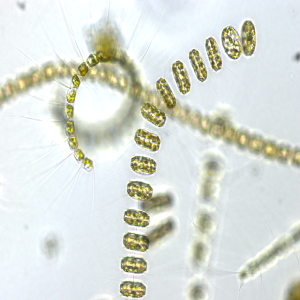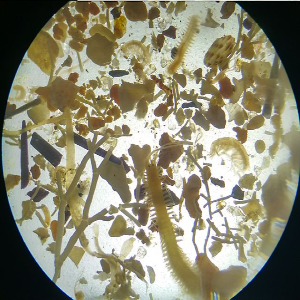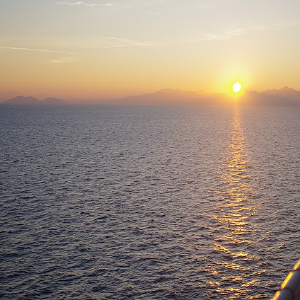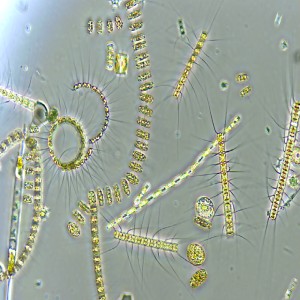A note about density staircases in the Gulf of Naples : 20 years of persistent weak salt-fingering layers in a coastal area
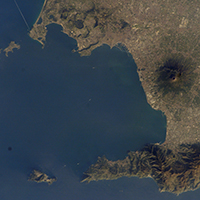
Accepted: 29 October 2021
HTML: 39
All claims expressed in this article are solely those of the authors and do not necessarily represent those of their affiliated organizations, or those of the publisher, the editors and the reviewers. Any product that may be evaluated in this article or claim that may be made by its manufacturer is not guaranteed or endorsed by the publisher.
This is a short communication about the inter-annual recurring presence at the coastal site in the Gulf of Naples of density staircases visible below the mixed surface layer of the water-column, from the end of summer to the beginning of winter, each year during nearly two decades of survey (2001 to 2020). We repetitively observe sequences from 1 to 4 small vertical staircases structures (~ 3 m thick) in the density profiles (~ Δ0.2 kg.m-3), located between 10 m to 50 m deep below the seasonal mixed layer depth. We interpret these vertical structures as the result of double diffusive processes that could host salt-fingering regime (SF) due to warm salty water parcels overlying on relatively fresher and colder layers. This common feature of the Mediterranean basin (i.e., the thermohaline staircases of the Tyrrhenian sea) may sign here for the lateral intrusions of nearshore water masses. These stably stratified layers are characterized by density ratio Rρ 5.0 to 10.0, slightly higher than the critical range (1.0 - 3.0) generally expected for fully developed salt-fingers. SF mixing, such as parameterized (Zhang et al., 1998), appears to inhibit weakly the effective eddy diffusivity with negative averaged value (~ - 1e-8 m2.s-1). A quasi 5-year cycle is visible in the inter-annual variability of the eddy diffusivity associated to SF, suggesting a decadal modulation of the parameters regulating the SF regime. Even contributing weakly to the turbulent mixing of the area, we hypothesis that SF could influence the seasonal stratification by intensifying the density of deep layers. Downward transfer of salt could have an impact on the nutrient supply for the biological communities, that remains to be determined.
Bebieva Y, Timmermans ML, 2017. The relationship between double-diffusive intrusions and staircases in the Arctic Ocean. Journal of Physical Oceanography 47:867-878.
Buffett GG, Krahman G, Klaeschen D, Schroeder K, Sallares V, papenberg C, et al., 2017. Seismic oceanography in the Tyrrhenian Sea - thermohaline staircases, eddies and internal waves. Journal of Geophysical Research: Oceans 122:8503-8523.
Carniel S, Sclavo M, Kantha L, Prandke Hartmut, 2008. Double-diffusive layers in the Adriatic Sea. Geophysical Research Letters 35:l02605.
Cianelli D, D’Alelio D, Uttieri M, Sarno D, Zingone A, Zambianchi E, et al., 2017. Disentangling physical and biological drivers of phytoplankton dynamics in a coastal system. Scientific Reports 7:15868.
Cianelli D, Falco P, Iermano I, Mozzillo P, Uttieri M, Buonocore B, et al., 2015. Inshore/offshore water exchange in the Gulf of Naples. Journal of Marine Systems 145:37-52.
Cianelli D, Uttieri M, Buonocore B, Falco P, Zambardino G, Zambianchi E, 2012. Dynamics of a very special Mediterranean coastal area: the Gulf of Naples, p.129-150. In: Williams G (ed.), Mediterranean Ecosystems: dynamics, management and conservation.
Compilation Group GEBCO, 2020. GEBCO 2020 Grid. Available at: https://www.gebco.net.
Copernicus Climate Change Service (C3S), 2017. ERA5: fifth generation of ECMWF atmospheric re-analyses of the global climate. Copernicus Climate Change Service Climate Data Store (CDS). Available at: https://climate.copernicus.eu/.
De Boyer Montegut C, Madec G, Fischer AS, Lazar A, Iudicone D, 2004. Mixed layer depth over the global ocean: an examination of profile data and profile-based climatology. Journal of Geophysical Research 109:c12003.
Durante S, Olivieri P, Nair R, Sparnocchia S, 2021. Mixing in the Tyrrhenian interior due to thermohaline staircases. Frontiers in Marine Science. Available at: https://www.frontiersin.org/articles/10.3389/fmars.2021.672437/full#:~:text=Thermohaline%20staircases%20are%20a%20well,feature%20of%20the%20Tyrrhenian%20Sea.&text=The%20staircases%20favor%20downward%20fluxes,salinity%20gradients%20are%20also%20high.
Durante S, Schroeder K, Mazzei L, Pierini S, Borghini M, Sparnocchia S, 2019. Permanent thermohaline staircases in the Tyrrhenian Sea. Geophysical Research Letters 46:1562-1570.
Falco P, 2016. Water mass structure and deep mixing processes in the Tyrrhenian Sea: results from the VECTOR project. Deep Sea Research Part I Oceanographic Research Papers 113: 7-21.
Fernandez Castro B, Mouriño-Carballido B, Marañon E, Chouciño P, Gago J, Ramirez T, et al., 2015. Importance of salt fingering for new nitrogen supply in the oligotrophic ocean. Nature Communications 6:8002.
Ferron B, Bouruet-Aubertot P, Schroeder K, Bryden H, Cuypers Y, Borghini M, 2021. Contribution of thermohaline staircases to deep water mass modifications in the Western Mediterranean Sea from microstructure observations. Frontiers in Marine Science 8:664509.
Inoue R. Kunze E, Laurent L, Schmitt R, Toole J, 2008. Evaluating salt-fingering theories. Journal of Marine Research 66:413-440.
Inoue R, Yamazaki H, Wolk F, Kono T, Yoshida J, 2007. An estimation of buoyancy flux for a mixture of turbulence and double-diffusion. Journal of Physical Oceanography 37:611-624.
IOC, SCOR, IAPSO, 2010. The international thermodynamic equation of seawater 2010: calculation and use of thermodynamic properties. Intergovernmental Oceanographic Commission, Manuals and Guides no.56, UNESCO, 196 pp.
Kanta L, Carniel S, Sclavo M, 2011. A note on modelling double-diffusive mixing in the global ocean. Ocean Modelling 36:40-48.
Kelley D, 1990. Fluxes through diffusive staircases, a new formulation. Journal of Geophysical Research 95:3365-3371.
Kokoszka F, Conversano F, Iudicone D, Ferron B, Bouruet-Aubertot P, McMillan J, 2021. Microstructure observations of the summer-to-winter destratification at a coastal site in the gulf of Naples. Earth and Space Science Open Archive, 36 pp.
Kunze E, 1987. Limits on growing, finite-length salt fingering, a Richardson Number constraint. Journal of Marine Research 45:533-556.
Kunze E, 2003. A review of oceanic salt-fingering theory. Progress in Oceanography 56:399-417.
Lenn, YD, Wiles PJ, Torres-Valdes S, Abrahamsen EP, Rippeth TP, Simpson JH, et al., 2009. Vertical mixing at intermediate depths in the Arctic boundary current. Geophysical Research Letters 36:l05601.
Linden PF, 1973. On the structure of salt fingers. Deep Sea Research 20:325-332.
Ma Y, Peltier W, 2021. Gamma instability in an inhomogeneous environment and salt-fingering staircase trapping: determining the step size. Physical Review Fluids 6:033903.
Malki-Epshtein L, Huppert H, 2004. Internal waves and velocity scales of double diffusive intrusions. APS Division of Fluid Dynamics Meeting Abstracts 57:eb004.
Maurer B, Linden P, 2014. Intrusion-generated waves in a linearly stratified fluid. Journal of Fluid Mechanics 752: 282-295.
McDougall TJ, Barker PM, 2011. Getting started with TEOS-10 and the Gibbs seawater (GSW) oceanographic toolbox. Available at: http://www.teos-10.org/pubs/Getting_Started.pdf.
Meccia V, Simoncelli S, Sparnocchia S, 2016. Decadal variability of the Turner angle in the Mediterranean Sea and its implications for double diffusion. Deep Sea Research Part I: Oceanographic Research Papers 114:64-77.
Merryfield W, 2000. Origin of thermohaline staircases. Journal of Physical Oceanography 30:1046-1068.
Merryfield W, Holloway G, Gargett A, 1999. A global ocean model with double-diffusive mixing. Journal of Physical Oceanography 29:1124-1142.
Nakano H, Shimada K, Nemoto M, Yoshida J, 2014. Parametrization of the eddy diffusivity due to double diffusive convection. Mer 52:91-98.
Nakano H, Yoshida J, 2019. A note on estimating eddy diffusivity for oceanic double-diffusive convection. Journal of Oceanography 75:375-393.
O’Brien T, Lorenzoni L, Isensee K, Valdes L, 2016. What are marine ecological time series telling us about the ocean? A status report. IOC Unesco Technical Series 129. Available at: https://igmets.net/report.
Oschlies A, Dietze H, Kähler P, 2003. Salt-finger driven enhancement of upper ocean nutrient supply. Geophysical Research Letters 30:2204.
Pujiana K, Moum JN, Smyth WD, 2018. The role of turbulence in redistributing upper-ocean heat, freshwater, and momentum in response to the MJO in the equatorial Indian ocean. Journal of Physical Oceanography 48:197-220.
Radko T, Bulters A, Flanagar J, Campin JM, 2014. Double-diffusive recipes. Part I: large-scale dynamics of thermohaline staircases. Journal of Physical Oceanography 44:1269-1284.
Radko T, Smith D, 2012. Equilibrium transport in double-diffusive convection. Journal of Fluid Mechanics 692:5-27.
Ribera d’Alcalà M, Conversano F, Corato F, Licandro P, Mangoni O, Marino D, et al., 2004. Seasonal patterns in plankton communities in pluriannual time series at a coastal Mediterranean site (Gulf of Naples); an attempt to discern recurrences and trends. Scientia Marina 68:65-83.
Ruddick B, 1983. A practical indicator of the stability of the water column to double-diffusive activity. Deep Sea Research Part A. Oceanographic Research Papers 30:1105-1107.
Ruddick B, Anis A, Thompson K, 2000. Maximum likelihood spectral fitting: the Batchelor spectrum. Journal of Atmospheric and Oceanic Technology 17:1541-1555.
Ruddick B, Kerr O, 2003. Oceanic thermohaline intrusions: theory. Progress in Oceanography 56:483-497.
Ruddick B, Richards K, 2003. Oceanic thermohaline intrusions: observations. Progress in Oceanography 56:499-527.
Ruddick B, Turner J, 1979. The vertical length scale of double-diffusive intrusions. Deep Sea Research Part A. Oceanographic Research Papers 26:903-913.
Schmid M, Busbridge M, Est A, 2010. Double-diffusive convection in Lake Kivu. Limnology and Oceanography 55:225-238.
Schmitt R, Ledwell J, Montgomery E, Polzin K, Toole J, 2005. Enhanced diapycnal mixing by salt-fingers in the thermocline of the Tropical Atlantic. Science 308:685-688.
Shibley N, Timmermans ML, Carpenter JR, Toole J, 2017. Spatial variability of the Arctic Ocean’s double diffusive staircase. Journal of Geophysical Research: Oceans 122:980-994.
Stern M, 1960. The salt-fountain and thermohaline convection. Tellus 12:172-175.
Stommel H, Arons A, Blanchard D, 1956. An oceanographical curiosity, the perpetual salt fountain. Deep Sea Research 3:152-153.
Taillandier V, Prieur L, D’Ortenzio F, Ribera d’Alcalà M, Pulido-Villena E, 2020. Profiling float observation of thermohaline staircases in the Western Mediterranean Sea and impact on nutrient fluxes. Biogeosciences 17:3343-3366.
Timmermans ML, Garrett C, Carmack E, 2003. The thermohaline structure and evolution of the deep-water in the Canada Basin, Arctic Ocean. Deep Sea Research Part I: Oceanographic Research Papers 50:1305-1321.
Timmermans ML, Toole J, Krishfield R, Winsor P, 2008. Ice-tethered profiler observations of the double-diffusive staircase in the Canada Basin thermocline. Journal of Geophysical Research 113:c00a002.
Turner J, 1967. Salt fingers across a density interface. Deep Sea Research and Oceanographic Abstracts 14:599-611.
Turner J, 1973. Buoyancy effects in fluids. Cambridge University Press, Cambridge, UK, 368 pp.
Turner J, 1983. Oceanic fine and microstructure, p.35-55. In: Brewer PG (ed.), Oceanography, the present and future: from the proceedings of 'Will we use the oceans wisely-the next fifty years in oceanography', September 29-October 2, 1980, Woods Hole, Massachusetts, USA.
Umlauf L, Holtermann P, Gillner C, Prien R, Merckelbach L, Carpenter J, 2018. Diffusive convection under rapidly varying conditions. Journal of Physical Oceanography 48:1731-1747.
Van der Boog C, Dijkstra H, Pietrzak J, Katsman C, 2021. Double-diffusive mixing makes a small contribution to the global ocean circulation. Communications Earth and Environment 2:46.
Volosciuk C, Maraun D, Semenov VA, Tilinina N, Gulev SK, Latif M, 2016. Rising Mediterranean Sea surface temperatures amplify extreme summer precipitation in Central Europe. Scientific Reports 6:32450.
You Y, 2002. A global ocean climatological atlas of the Turner angle: implications for double-diffusion and water-mass structure. Deep Sea Research Part I: Oceanographic Research Papers 49:2075-2093.
Zingone A, Casotti R, Ribera d’Alcalà M, Scardi M, Marino D, 1995. St. Martin’s Summer – the case of an autumn phytoplankton bloom in the Gulf of Naples (Mediterranean Sea). Journal of Plankton Research 17:575-593.
Zingone A, D’Alelio D, Mazzocchi MG, Montresor M, Sarno D, 2019. Time series and beyond: multi-faceted plankton research at a marine Mediterranean LTER site. Nature Conservation 34:273-310.
Zingone A, Dubroca L, Iudicone D, Margiotta F, Corato F, Ribera d’Alcalà M, et al., 2010. Coastal phytoplankton do not rest in winter. Estuaries and Coasts 33:342-361.
Zhang J, Schmitt R, Huang R, 1998. Sensitivity of the GFDL modular ocean model to parametrization of double-diffusive processes. Journal of Physical Oceanography 28:589-605.
Zodiatis G, Gasparini G, 1996. Thermohaline staircase formations in the Tyrrhenian Sea. Deep Sea Research Part I: Oceanographic Research Papers 43:655-678.
PAGEPress has chosen to apply the Creative Commons Attribution NonCommercial 4.0 International License (CC BY-NC 4.0) to all manuscripts to be published.



 https://doi.org/10.4081/aiol.2021.10008
https://doi.org/10.4081/aiol.2021.10008




